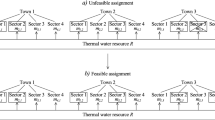Abstract
The use of Lagrange multipliers for decentralization of large resource allocation problems is well known. However, these dual techniques may suffer from the drawback ofduality gaps, to guarantee the absence of which various functions are required to be convex. This limits greatly the applicability of the decentralized approach. We show that less restrictive conditions can be formulated for a certain class of allocation problems, which we call resource management problems, which typically occur in large operational systems. We present a theorem for the existence of optimal multipliers, while placing almost no restrictions on the forms of the resource usage functions or the domains of the decision variables. Efficient solution algorithms, with provable convergence properties, have been given in a companion paper. Our results justify the application of dual methods to this class ofreal-world problems.
Similar content being viewed by others
References
Arrow, K. J., andHurwicz, L.,Decentralization and Computation in Resource Allocation, Essays in Economics and Econometrics, Edited by R. W. Pfouts, University of North Carolina Press, Raleigh, North Carolina, 1960.
Everett, H.,Generalized Lagrange Multiplier Method for Solving Problems of Optimum Allocation of Resources, Operations Research, Vol. 11, pp. 399–417, 1963.
Geoffrion, A. M.,Elements of Large-Scale Mathematical Programming, Management Science, Vol. 16, pp. 652–691, 1970.
Lasdon, L. S.,Optimization Theory for Large Systems, The Macmillan Company, New York, New York, 1970.
Shapiro, J. F.,A Survey of Lagrangian Techniques for Discrete Optimization, Massachusetts Institute of Technology, Cambridge, Massachusetts, Operations Research Center, Technical Report No. 133, 1977.
Shapiro, J. F.,Nondifferentiable Optimization and Large-Scale Linear Programming, Lecture Notes in Control and Information Sciences, Vol. 14, Edited by A. V. Balakrishnan and M. Thoma, Springer-Verlag, Germany, Berlin, 1979.
Geoffrion, A. M.,Duality in Nonlinear Programming: A Simplified Applications-Oriented Development, SIAM Review, Vol. 13, pp. 1–37, 1971.
Luenberger, D. G.,Optimization by Vector Space Methods, John Wiley and Sons, New York, New York, 1969.
Suri, R., andHo, Y. C.,Resource Management for Large Systems: Concepts, Algorithms, and an Application, IEEE Transactions on Automatic Control, Vol. AC-25, pp. 651–662, 1980.
Suri, R.,Resource Management in Large Systems, Harvard University, Cambridge, Massachusetts, Division of Applied Sciences, Technical Report No. 671, 1978.
Suri, R.,A Decentralized Approach to Optimal the Allocation in Computer Networks, Proceedings of 18th IEEE Conference on Decision and Control, Ft. Lauderdale, Florida, 1979.
Mahmoud, S., andRiordan, J. S.,Optimal Allocation of Resources in Distributed Information Networks, ACM Transactions on Database Systems, Vol. 1, pp. 66–78, 1976.
Chang, S. K.,A Model for Distributed Computer System Design, IEEE Transactions on Systems, Man, and Cybernetics, Vol. SMC-5, pp. 344–359, 1976.
Levis, A. H.,Large-Scale Systems Effectiveness Analysis: First Annual Milestone Report, Systems Control, Palo Alto, California, 1978.
Dantzig, G. B.,Linear Programming and Extensions, Princeton University Press, Princeton, New Jersey, 1963.
Starr, R.,Quasi-Equilibria in Markets with Nonconvex Preferences, Econometrica, Vol. 37, pp. 35–38, 1967.
Stoer, J., andWitzgall, C.,Convexity and Optimization in Finite Dimensions, Vol. 1, Springer-Verlag, Berlin, Germany, 1970.
Magnanti, T. L., Shapiro, J. F., andWagner, M. H.,Generalized Linear Programming Solves the Dual, Management Science, Vol. 22, pp. 1195–1203, 1976.
Ekeland, I. Une Estimation à Priori en Programmation Nonconvexe, Comptes Rendus de l'Académie des Sciences, Paris, France, Vol. 279, Série A, pp. 149–151, 1974.
Aubin, J. P., andEkeland, I.,Estimates of the Duality Gap in Nonconvex Optimization, Mathematics of Operations Research, Vol. 1, pp. 225–245, 1976.
Bertsekas, D. P.,Multiplier Methods: A Survey, Automatica, Vol. 12, pp. 133–145, 1976.
Author information
Authors and Affiliations
Additional information
Communicated by D. Q. Mayne
The author is indebted to Mr. G. Karady and Professor Y. C. Ho of Harvard University for their valuable comments, and also to the referees for their helpful suggestions. This research was partially supported by the Office of Naval Research, under the Joint Services Electronic Program, Contract No. N0001475-C-0648, and by the National Science Foundation, Grant No. ENG-78-15231.
Rights and permissions
About this article
Cite this article
Suri, R. Existence of optimal Lagrange multipliers for certain nonconvex allocation problems. J Optim Theory Appl 34, 169–196 (1981). https://doi.org/10.1007/BF00935472
Issue Date:
DOI: https://doi.org/10.1007/BF00935472




